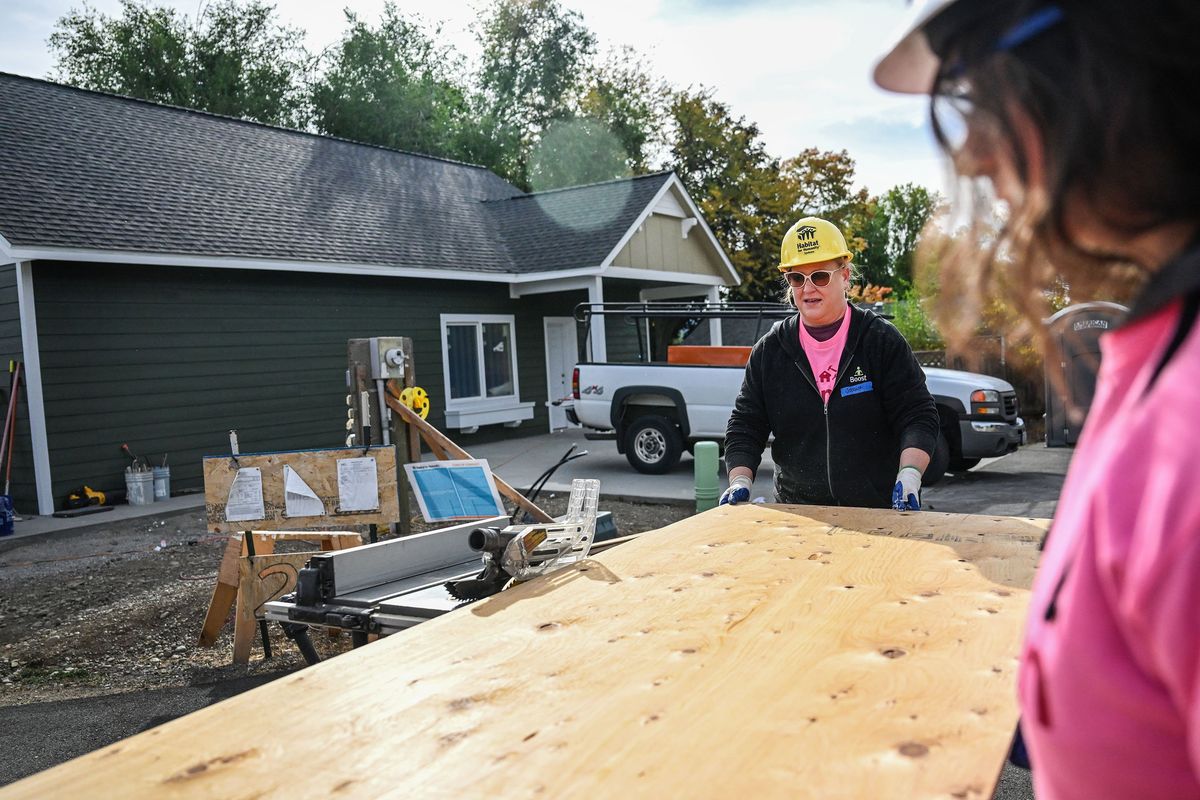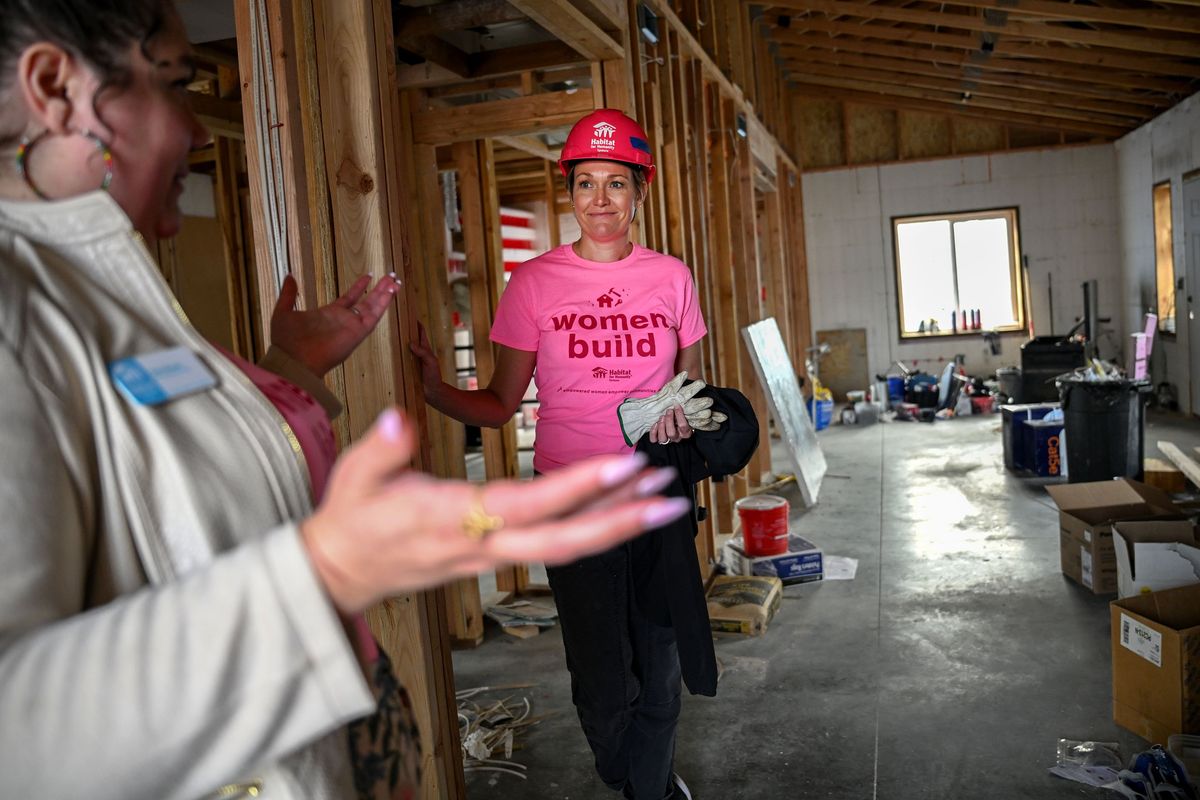‘Removing the stigma of charity’: Organization embraced by President Jimmy Carter remains an important force for housing in Spokane
Habitat For Humanity volunteer Jessica Todd (center) cuts a board during project Oct. 9 in Spokane Valley. (Kathy Plonka/The Spokesman-Review)
Jimmy Carter traveled the country and the world, wearing a toolbelt, swinging a hammer and shaking hands with regular people inspired to help others in their communities.
His humble nature and willingness to be an ambassador for Habitat for Humanity, using the bully pulpit as a former U.S. president, cemented a legacy of how the most powerful people can forge real change.
The nation mourned Carter’s death on Thursday with a state funeral, recognizing his official achievements and reflecting on his noble post-presidential life helping the poor.
As Carter turned 100 in the fall, the Spokane chapter of Habitat for Humanity acknowledged and honored his longevity by … keeping at it. More than a dozen volunteers, clad in pink shirts and hardhats, were building a fence, sawing boards and cleaning up worksite debris as they worked on a cluster of new homes in Spokane Valley to give families a chance at home ownership.
“President Carter breathed humanity into this mission,” said Michelle Girardot, chief executive officer of Habitat-Spokane.
In 1987, a small group of volunteers founded the Spokane chapter of Habitat. They met in the basement of St. Mark’s Lutheran Church on the South Hill with the idea of doing something good.
Word spread, and within a year, Spokane had answered the call with 100 volunteers, 35 committee members and a mailing list of 500 before it even started its first housing project, Grace Harris, the chapter’s first president, told The Spokesman-Review, according to August 1987 news clippings.
By June 1988, Habitat-Spokane purchased its first two properties: a vacant lot at 818 E. 10th Ave. bought from the Childrens’ Home Society and a home in need of rehabilitation at 2611 E. Sixth Ave. that sold for $10,500 from the Veterans Administration.
The first family selected to buy a Habitat home in Spokane was a homeless single mother with three children, according to a news account at the time.
By late September 1988, the Sixth Avenue house rehab, which included new plumbing, wiring, insulation, paint and roof – costing a total of $4,000 – was finished and ready for occupancy. The new owner was to make monthly payments of $100, plus taxes and insurance.
During the next 36 years, the local chapter has built or rehabilitated more than 430 homes across the county, including a string of houses near Liberty Park in the East Central Neighborhood and new homes in Deer Park.
And there’s more to come.
Last year, a family moved into the Spokane Valley home. Habitat builders are working to build three neighboring duplexes, in essence injecting seven new families into a neighborhood with a mix of apartments, small farms with goats and chickens, churches, vacant land and other single-family homes.
Spearheading the effort during a fall day was Jessica Golladay, a vice president at STCU and a member of the local Habitat’s Women’s Build Steering Committee.
She marveled at the persistence of volunteers helping people they don’t know.
“They give their time, talent and treasure,” Golladay said. “We gather our friends and co-workers for the cause of affordable housing. We show up.”
In December, the local chapter celebrated a newly built home in Airway Heights that will belong to a family of seven.
Habitat has had to adapt to what has become a roaring housing market that’s seemingly put home ownership out of reach for a new generation.
“In the good old days, we could get people into a home for $65,000. A lot has changed,” Girardot said. “Today, it’s complex to make it all work.”
Look no further than a waitlist of some 700 people hoping for a Habitat house.
There are many layers of financing in play as Habitat arranges an affordable housing loan to help, but that house today might still cost a new Habitat homeowner $280,000 to $345,000, she said.
“We’re helping teachers, nurses, social workers, insurance agents. They’re not who a lot of people expect,” Girardot said.
That’s what housing has to often become – an American nightmare for young adults and struggling families. And that’s where Habitat plays a role.
A lot of first-time homes are getting snapped up because of the pressure on the housing stock, Golladay said.
So Habitat is trying to do seven to 10 rehabs a year.
Those are salvage projects that Habitat is anxious to take on. They breathe new life into properties and improve neighborhoods, she said.
And that gives people hope, just as Carter did as he put his energy into an upstart group trying to change the world.
Clarence Jordan, a farmer and religious scholar, hatched the idea on a community farm near Americus, Georgia, in the late 1960s. He worked with Millard and Linda Fuller, who then founded Habitat on the concept of what the organization calls “partnership housing,” according to its written history.
In 1976, the Fullers founded Habitat for Humanity International and began building its first house in San Antonio, Texas.
Within years after voters turned him out of the White House in 1980, Carter and his wife, Rosalynn, found their next passion.
In 1984, the Carters joined Habitat for a work project in New York City.
“Habitat has successfully removed the stigma of charity by substituting it with a sense of partnership,” Carter said.
That concept and Carter’s embrace of the organization supercharged Habitat’s effectiveness and growth.
“We just continue to celebrate the many lives that he helped change,” Girardot said. “Jimmy Carter is a person who will be very much missed in many of the ways we miss Mrs. Carter.”

